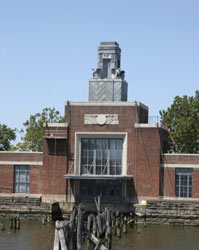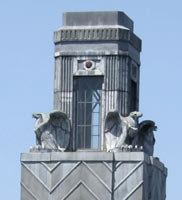Ellis Island Restoration Gives New Life to Ferry Building's Cupola Sculpture
 Recently restored Ferry Building, Ellis Island
Recently restored Ferry Building, Ellis IslandPhotograph by Valerie Loiseleux
At the southern end of the most famous island in the midst of New York Harbor sits one of the most recognized and revered sites in the world-the Statue of Liberty and Ellis Island. American history has portrayed this patriotic site in movies, documentaries and articles, but nothing prepares visitors for the actual feeling of standing and experiencing the excitement and raw emotions our ancestors must have felt as they walked through the "Gateway to America".
In the 1950s, part of the island known as the Ferry Building that was the first step on American soil for immigrants in the early 1900s was closed to the public, but has since received a second chance. After more than 50 years, the Ferry Building has reopened thanks to a $6.4 million renovation project. Visitors can once again stroll this majestic site to see the Art Deco restorations, including a facelift of the beautifully restored copper cupola and eagle sculpture that greeted over 12 million immigrants coming to America.
"We assumed that they were lead coated copper, however, I have a copy of the original drawing of the cupola and it indicates that they're actually cast lead," says Don Fiorino, Supervising Architect for the National Park Service, in New York. "The cupola was restored in two phases-the lower portion that has the chevrons were replaced entirely with Revere Copper, Freedom Gray, a zinc-coated copper in lieu of lead because the park was trying to go lead-free environmentally. The upper cap was done later on and we salvaged the existing ornamental fluted band that was on the upper top. The existing cap had deteriorated severely and was one of the reasons water dripped into the building. When we replaced the cap we salvaged the existing ornamental band and attached it to the new cap, therefore retaining some of the historic fabric."
 Detail of Ferry Building Cupola
Detail of Ferry Building CupolaPhotograph by Valerie Loiseleux
The center section with the windows and fluted plates, according to Fiorino, were all existing and included the eagles, windows and fluted window surrounds. The lower portion with the chevrons was rebuilt with a steel frame inside and wood sheathing, all reclad in Revere Copper, Freedom Gray.
"We assumed the eagles were lead coated copper but looking at old copies it says that the tower base is noted to be lead plates," he explains. "We removed whatever remained and replaced it with zinc-coated , Freedom Gray copper. There is one eagle in each corner, and they are hollow, not solid. Since the balance of the material is lead coated copper, it leads us to believe that they are, in fact, lead coated copper as well. There was no major repair work performed on the eagles, so we did not have the need to cut it open to examine the material. The Public Works Administration created the cupola and building, and the drawings were prepared with Louis A. Simon acting as Supervising Architect as well as Chester H. Aldrich, the original architect. On his sketches it says that the eagles are approximately 4'8 and located on the four corners of the cupola."
The building was started in 1934 and completed in 1936. Restorations were done in two phases, with one in 2001, and another and phase in 2004.
Resources:
For more information about Ellis Island contact the Statue of Liberty-Ellis Island Foundation (SOLEIF), or call the National Parks and Services at (212) 363-3206.
More information on the history and restoration of the Statue of Liberty.
Also in this Issue:
- Copper Catalyst: Evelyn Rosenberg's Explosive Art of Detonography
- Val Bertoia: Alloy and Metaphor
- Mark Oberkirsch and the Art of Copper Repoussé
- Carnegie Museum of Natural History Reopens Hillman Hall of Minerals and Gems
- Ellis Island Restoration Gives New Life to Ferry Building's Cupola Sculpture
